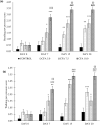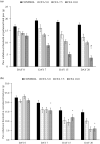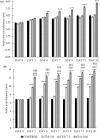Effects of different doses of complete Freund's adjuvant on nociceptive behaviour and inflammatory parameters in polyarthritic rat model mimicking rheumatoid arthritis
- PMID: 34879087
- PMCID: PMC8654228
- DOI: 10.1371/journal.pone.0260423
Effects of different doses of complete Freund's adjuvant on nociceptive behaviour and inflammatory parameters in polyarthritic rat model mimicking rheumatoid arthritis
Abstract
Complete Freund's adjuvant (CFA) has been used to develop the arthritic or inflammatory condition in the animal, but there is a lack of information concerning high CFA doses on nociceptive behaviour and inflammatory parameters. This study aimed to compare the effects of different high doses of CFA in rat to closely mimic nociceptive and inflammatory parameters of rheumatoid arthritis (RA) in humans. Twenty-four male Sprague-Dawley rats were randomly divided into four groups (n = 6): Control (C), CFA-induced polyarthritic groups at 5.0 mg/mL (CFA 5.0), 7.5 mg/mL (CFA 7.5) and 10.0mg/mL (CFA 10.0). The rats' right hindpaw was inoculated with CFA intradermally and developed into a polyarthritic state within 20 days. Nociceptive behavioural assessments, including von Frey and hot plate tests and spontaneous activities, were conducted on day 0, 7, 15 and 20. Bilateral ankle joints diameter and circumference, full blood count, joints and paw histological examinations were also conducted throughout the study period. Based on the results, CFA 5.0 and CFA 7.5 groups showed a significant increase in spontaneous activities and development of thermal hyperalgesia but no change in body weight and food intake, no development of tactile allodynia and haematological indices, and no significant morphological changes of joints histology. Meanwhile, CFA 10.0 group demonstrated significant and constant changes in all nociceptive and inflammatory parameters investigated. In conclusion, CFA at the dose of 10mg/mL has the most potential and reliable dosage to develop polyarthritis in a rat model to mimic RA condition in humans.
Conflict of interest statement
The authors have declared no competing interests exist.
Figures










Similar articles
-
Effects of different doses of Ganoderic Acid A on nociceptive behaviour and inflammatory parameters in polyarthritic mice rheumatoid arthritis model.Sci Rep. 2025 May 6;15(1):15759. doi: 10.1038/s41598-025-99917-6. Sci Rep. 2025. PMID: 40328991 Free PMC article.
-
Cardamonin (2',4'-dihydroxy-6'-methoxychalcone) isolated from Boesenbergia rotunda (L.) Mansf. inhibits CFA-induced rheumatoid arthritis in rats.Eur J Pharmacol. 2017 Jan 5;794:127-134. doi: 10.1016/j.ejphar.2016.11.009. Epub 2016 Nov 11. Eur J Pharmacol. 2017. PMID: 27845065
-
Anti-arthritic and Antioxidant Effects of Trehalose in an Experimental Model of Arthritis.Recent Adv Inflamm Allergy Drug Discov. 2023;17(2):145-151. doi: 10.2174/2772270817666230825093141. Recent Adv Inflamm Allergy Drug Discov. 2023. PMID: 37622696
-
Effects of sex, hindpaw injection site and stimulus modality on nociceptive sensitivity in arthritic rats.Physiol Behav. 2006 Mar 30;87(3):552-62. doi: 10.1016/j.physbeh.2005.12.005. Epub 2006 Feb 7. Physiol Behav. 2006. PMID: 16455114
-
Andrographolide ameliorates oxidative stress, inflammation and histological outcome in complete Freund's adjuvant-induced arthritis.Chem Biol Interact. 2020 Mar 1;319:108984. doi: 10.1016/j.cbi.2020.108984. Epub 2020 Feb 13. Chem Biol Interact. 2020. PMID: 32061742
Cited by
-
Assessing the Impact of Influenza Vaccination Timing on Experimental Arthritis: Effects on Disease Progression and Inflammatory Biomarkers.Int J Mol Sci. 2024 Mar 14;25(6):3292. doi: 10.3390/ijms25063292. Int J Mol Sci. 2024. PMID: 38542266 Free PMC article.
-
A Novel Diabetic Arthritic Model in Rats Induced by Streptozotocin, High-Fat Diet, and Complete Freund's Adjuvant.Orthop Res Rev. 2024 Jun 11;16:163-170. doi: 10.2147/ORR.S457848. eCollection 2024. Orthop Res Rev. 2024. PMID: 38882468 Free PMC article.
-
Ondansetron or beta-sitosterol antagonizes inflammatory responses in liver, kidney, lung and heart tissues of irradiated arthritic rats model.Int J Immunopathol Pharmacol. 2024 Jan-Dec;38:3946320241260635. doi: 10.1177/03946320241260635. Int J Immunopathol Pharmacol. 2024. PMID: 38831558 Free PMC article.
-
Comprehensive phytochemical characterization of Persea americana Mill. fruit via UPLC/HR-ESI-MS/MS and anti-arthritic evaluation using adjuvant-induced arthritis model.Inflammopharmacology. 2023 Dec;31(6):3243-3262. doi: 10.1007/s10787-023-01365-z. Epub 2023 Nov 7. Inflammopharmacology. 2023. PMID: 37936023 Free PMC article.
-
Distinct therapeutic effects of auraptene and umbelliprenin on TNF-α and IL-17 levels in a murine model of chronic inflammation.Heliyon. 2024 Nov 26;10(23):e40731. doi: 10.1016/j.heliyon.2024.e40731. eCollection 2024 Dec 15. Heliyon. 2024. PMID: 39687160 Free PMC article.
References
-
- Kim JM, Kim HY. Pathogenesis of rheumatoid arthritis. J Korean Med Assoc. 2010; 53(10):853–61
-
- Allan Gibofsky. Epidemiology, pathophysiology, and diagnosis of rheumatoid arthritis: A synopsis. Am J Manag Care. 2014; 20(7 Suppl):S128–135. - PubMed
Publication types
MeSH terms
Substances
LinkOut - more resources
Full Text Sources
Medical

